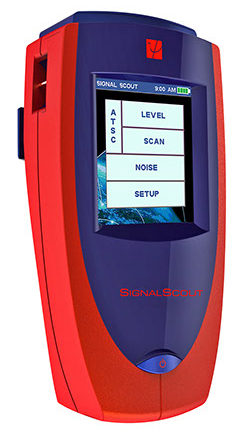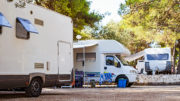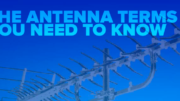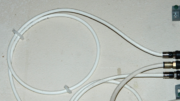Without a doubt, the best way to measure an antenna’s performance is the use of a good signal meter. It’s not just raw signal strength… you can find that out with a cheap signal finder. With digital signals you really need a meter that will decode the signal and tell you what’s really going on with in. This SignalScout meter does a surprisingly good job with that stuff, and it’s going to satisfy most DIYers.
But what about lab tests?
The real question, though, is “will lab tests tell you how well an antenna will perform?” and the answer is definitely “no.” A lab test will tell you how well the antenna performs in a perfect environment and that’s great for comparing antennas. It’s a real challenge figuring out how well an antenna will work in your own home.
When I test antennas, I try to get real lab data from the manufacturers but sometimes it’s a challenge. Some of our past suppliers have obviously lied about their specs, and that’s why we don’t sell their products anymore. I know that my friends from Televes do a great job testing their products because I’ve seen their labs. I mean, they build their own signal meters, so they must have some idea what they are doing.
But really, the meaurements I trust are the ones I do myself. That’s right, I do my own testing on every antenna I review. I don’t have a $100,000 facility but I do have some consistent locations and I’ve developed procedures to make sure that it’s as scientific as possible.
My test parameters
My favorite test lab is our Southern California facility because it has the perfect combination of test conditions. It’s about 60 miles from the towers, meaning that it really tests the ability of an antenna to receive signals. The weather is pretty much the same year round and the facility doesn’t have a lot of trees. There are also about 25 broadcast channels including VHF channel 2 so I can really test a lot of different frequencies.
I always start with a baseline test using a 1-meter dipole that I built out of copper wire. I’ll admit that it isn’t a perfect antenna to test with. The perfect scenario would have me put together an antenna for every frequency I’m testing, with the length of the antenna being half the length of the broadcast wave (they call that a half-length dipole, for obvious reasons.) But that’s a lot of copper and a lot of time and a lot of space to store 25 different antennas. Maybe at some point.
Anyway, what I do is take measurements of that bare copper antenna on the day I’m doing testing. I aim it to get the strongest signal from the location where most of the signals originate. Then I do the same thing with the antenna I’m testing. Subtract one set of numbers from the other and you get a set of gain numbers.
No this is not a perfect method, and I admit that.
I admit that there are some flaws here. The bare wire antenna is going to be more sensitive on some frequencies than others, and that’s going to make the other antenna look less sensitive by comparison. It’s also impossible to completely duplicate results in real-world testing — I’ve seen signal levels vary by 4dB just as you’re sitting there reading the numbers. But this gives you an idea of real-world, outside the lab performance and as far as I know no other antenna merchant does this.
If I were to take this to the “nth” degree I’d build a set of dipoles, one for each active frequency, and measure performance of that dipole on the day of testing to try to get the best results. I don’t do this. I don’t think it really adds a lot to the conversation, since most antennas don’t have a full set of dipoles for each VHF frequency. (Our HD8200XL does, and it’s one of the only ones that does.) I don’t know of any antenna that uses more than one receiving element for UHF.
However, I do a pretty deep dive on the measurements I do take. I use a Televes spectrum analyzer to take full measurements of every frequency. This includes not only raw power but also signal-to-noise ratio, carrier-to-noise ratio, and bit error rate. If it’s an amplified antenna I take measurements in both amplified and unamplified states. Signal-to-noise ratio is really the most important measurement of TV antenna signals. Because TV signals are digital, it really doesn’t matter how much signal you have as long as it’s enough to overcome the ambient noise and the noise introduced by the cables.
A word about ATSC 3.0
As I write this, I do not measure ATSC 3.0 signals. ATSC 3.0, the proposed next-generation of digital broadcasting, uses more complex encoding. This potentially means better reception in some scenarios.
The reason I don’t measure it right now is that my current test rig doesn’t support it. However, that’s not a limitation for today. Because ATSC 3.0 is still in a test phase, nearly every ATSC 3.0 broadcast is paired with an ATSC 1.0 broadcast. I do see the signals from ATSC 3.0 towers, but my meter treats them as analog signals since it can’t decode them. Should the ATSC 3.0 standard be fully adopted, I’ll upgrade to an ATSC 3.0-capable meter. Right now those meters are insanely expensive and hopefully there will be some drops in price between now and then.
Get the right antenna from Solid Signal
Measurements are only part of the story. Do you need an indoor antenna? Does your HOA restrict you from putting an antenna up if it’s larger than 39″? There are all sorts of considerations you’ll have. That’s why you need an expert on your side. When you’re ready to talk, call us at 888-233-7563. Our corporate offices in the Detroit area are staffed with trained technicians who can help you understand exactly what you’ll need. We’ll give you a recommendation for the right antenna and the right accessories. Call us during East Coast business hours, or if it’s after hours, fill out the form below!





